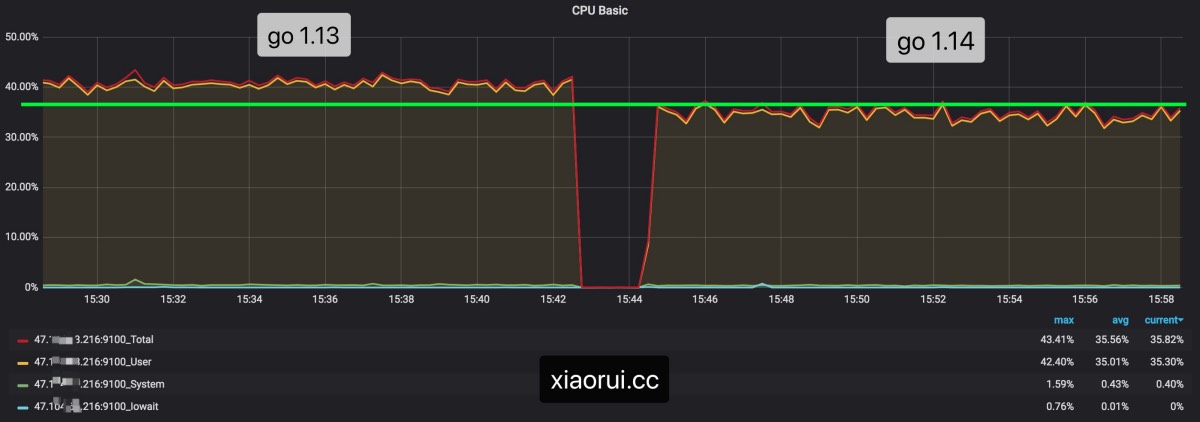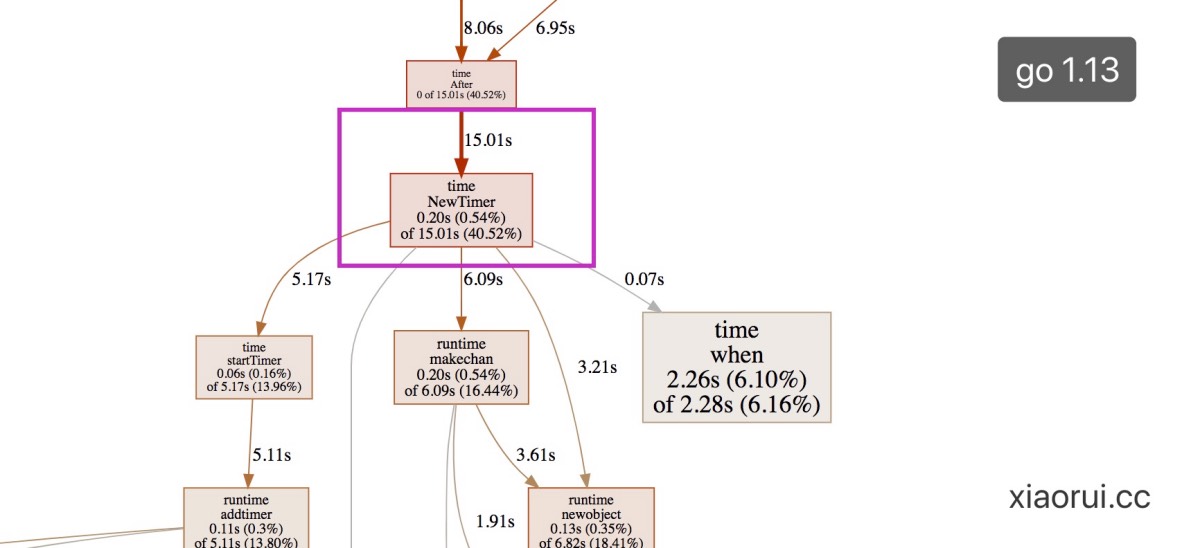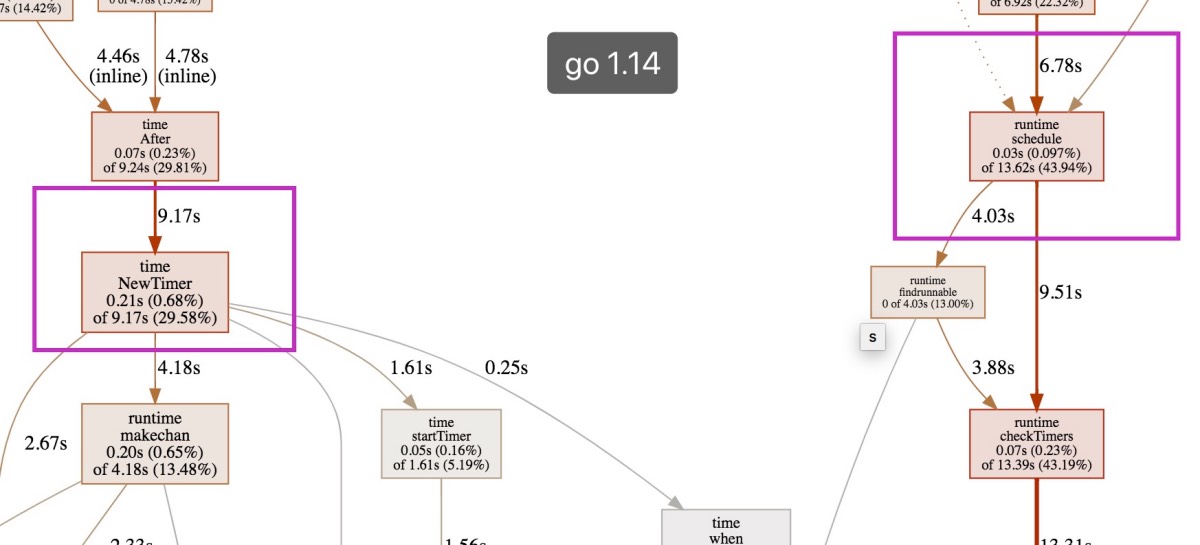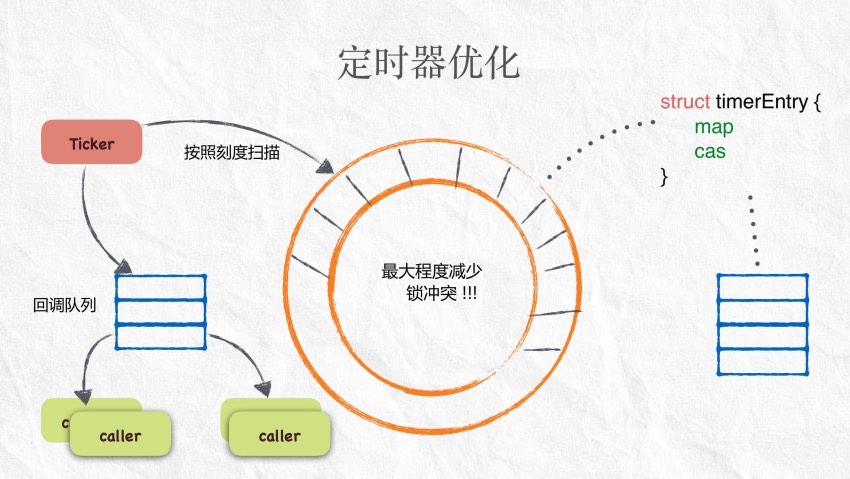

go1.14基于netpoll优化timer定时器实现原理
source link: http://xiaorui.cc/archives/6483
Go to the source link to view the article. You can view the picture content, updated content and better typesetting reading experience. If the link is broken, please click the button below to view the snapshot at that time.

go1.14基于netpoll优化timer定时器实现原理
golang1.14版的release已经发布有些时间了,在官方go1.14的介绍里有说优化了timer定时器。golang的定时器已经经历了几版的优化,但在依赖定时器的高性能场景,还是成为一个大的性能杀手。
看过我曾经做过技术分享的朋友会想到,我一直使用时间轮替换golang标准库中的timer。😅 想起了一个段子,不是你不够优秀,是哥对定时器的要求太高。
该文章后续仍在不断的更新修改中, 请移步到原文地址 http://xiaorui.cc/?p=6483

go1.13和go1.14的区别?
废话不多说,来好好介绍下定时器在go 1.13 和 go1.14中的区别?
golang在1.10版本之前是由一个独立的timerproc通过小顶堆和futexsleep来管理定时任务。1.10之后采用的方案是把独立的timerproc和小顶堆分成最多64个timerproc协程和四叉堆,用来休眠就近时间的方法还是依赖futex timeout机制。默认timerproc数量会跟GOMAXPROCS一致的,但最大也就64个,因为会被64取摸。
那么简单说go1.14版的timer是如何优化性能?首先把存放定时事件的四叉堆放到p结构中,另外取消了timerproc协程,转而使用netpoll的epoll wait来做就近时间的休眠等待。在每次runtime.schedule调度时都检查运行到期的定时器。
快速浏览go1.13的定时器实现原理
在这里简单的过一遍go1.13版定时器的实现,再细节可以看下我写过的文章。
不管是NewTimer、NewTicker、After等其实调用的都是addTimer来新增定时任务,assignBucket给当前协程分配一个timerBucket。go初始化时会预先实例化长度64的timers数组,通过协程的p跟64取摸来分配timerBucket。如果新的定时任务较新,那么使用notewakeup来激活唤醒timerproc的futex等待。如果发现没有实例化timerproc,则启动。
// xiaorui.cc
const timersLen = 64
var timers [timersLen]struct {
timersBucket
}
func addtimer(t *timer) {
tb := t.assignBucket()
lock(&tb.lock)
ok := tb.addtimerLocked(t)
unlock(&tb.lock)
,,,
}
func (t *timer) assignBucket() *timersBucket {
id := uint8(getg().m.p.ptr().id) % timersLen
t.tb = &timers[id].timersBucket
return t.tb
}
func (tb *timersBucket) addtimerLocked(t *timer) bool {
t.i = len(tb.t)
tb.t = append(tb.t, t)
if !siftupTimer(tb.t, t.i) {
return false
}
if t.i == 0 {
if tb.sleeping && tb.sleepUntil > t.when {
tb.sleeping = false
notewakeup(&tb.waitnote)
}
,,,
if !tb.created {
tb.created = true
go timerproc(tb)
}
}
return true
}timerproc协程运行时会从堆顶拿timer,然后判断是否到期,到期则直接执行,当bucket无任务时,调用runtime.goparkunlock来休眠该协程。当至少有一个timer任务时,则通过notetsleepg传入下次的到期时间来进行休眠。值得一说的是notetsleepg会调用entersyscallblock触发handoffp,这个问题我们在文章后有说明。
// xiaorui.cc
func timerproc(tb *timersBucket) {
tb.gp = getg()
for {
lock(&tb.lock)
now := nanotime()
delta := int64(-1)
for {
t := tb.t[0]
delta = t.when - now
if delta > 0 {
break
}
arg := t.arg
seq := t.seq
unlock(&tb.lock)
,,,
f(arg, seq)
lock(&tb.lock)
}
if delta < 0 || faketime > 0 {
// No timers left - put goroutine to sleep.
goparkunlock(&tb.lock, waitReasonTimerGoroutineIdle, traceEvGoBlock, 1)
continue
}
}
,,,
tb.sleepUntil = now + delta
unlock(&tb.lock)
notetsleepg(&tb.waitnote, delta)
}timerproc的notetsleepg用来休眠,addTimerLocked的notewakeup用来唤醒。
// xiaorui.cc
// notetsleepg -> notetsleep_internal -> futexsleep
func futexsleep(addr *uint32, val uint32, ns int64) {
var ts timespec
ts.setNsec(ns)
futex(unsafe.Pointer(addr), _FUTEX_WAIT_PRIVATE, val, unsafe.Pointer(&ts), nil, 0)
}
// notewakeup -> futexwakeup
func futexwakeup(addr *uint32, cnt uint32) {
ret := futex(unsafe.Pointer(addr), _FUTEX_WAKE_PRIVATE, cnt, nil, nil, 0)
,,,
}源码分析go1.14 timer
在struct p中定义了timer相关字段,timers数组用来做四叉堆数据结构。
// xiaorui.cc
type p struct {
// 保护timers堆读写安全
timersLock mutex
// 存放定时器任务
timers []*timer
,,,
}定时器timer结构的定义.
// xiaorui.cc
type timer struct {
pp puintptr // p的位置
when int64 // 到期时间
period int64 // 周期时间,适合ticker
f func(interface{}, uintptr) // 回调方法
arg interface{} // 参数
seq uintptr // 序号
nextwhen int64 // 下次的到期时间
status uint32 // 状态
}如何增加定时任务的?
我们调用NewTimer、After、AfterFunc时会构建runtimeTimer定时结构,然后通过runttime.startTimer来插入到时间堆里。另外在修改,重置定时器的逻辑都会尝试调用wakeNetPoller来唤醒netpoller。
注意,time/sleep.go里的runtimeTimer跟runtime的timer结构是一致的。
// xiaorui.cc
time/sleep.go
func NewTimer(d Duration) *Timer {
c := make(chan Time, 1)
t := &Timer{
C: c,
r: runtimeTimer{
when: when(d),
f: sendTime,
arg: c,
},
}
startTimer(&t.r)
return t
}
func After(d Duration) <-chan Time {
return NewTimer(d).C
}
func AfterFunc(d Duration, f func()) *Timer {
t := &Timer{
r: runtimeTimer{
when: when(d),
f: goFunc,
arg: f,
},
}
startTimer(&t.r)
return t
}
func goFunc(arg interface{}, seq uintptr) {
go arg.(func())()
}
func sendTime(c interface{}, seq uintptr) {
select {
case c.(chan Time) <- Now():
default:
}
}下面是具体操作定时器添加的过程,time/sleep.go可以理解为应用层定时器的封装,runtime/time.go是定时器调度的封装。
// xiaorui.cc
// 通过link做方法映射,简单说time/sleep.go里调用的time.startTimer其实是runtime包里的。
//go:linkname startTimer time.startTimer
func startTimer(t *timer) {
addtimer(t)
}
// 把定时任务放到当前g关联的P里。
func addtimer(t *timer) {
if t.when < 0 {
t.when = maxWhen
}
t.status = timerWaiting // 状态为等待中
addInitializedTimer(t)
}
// 加锁来清理任务,并且增加定时任务,最后根据时间就近来唤醒netpoll
func addInitializedTimer(t *timer) {
when := t.when
pp := getg().m.p.ptr()
lock(&pp.timersLock)
ok := cleantimers(pp) && doaddtimer(pp, t)
unlock(&pp.timersLock)
if !ok {
badTimer()
}
wakeNetPoller(when)
}当新添加的定时任务when小于netpoll等待的时间,那么wakeNetPoller会激活NetPoll的等待。激活的方法很简单,在findrunnable里的最后会使用超时阻塞的方法调用epollwait,这样既可监控了epfd红黑树上的fd,又可兼顾最近的定时任务的等待。
// xiaorui.cc
var (
epfd int32 = -1 // epoll descriptor
netpollBreakRd, netpollBreakWr uintptr // 用来给netpoll中断
)
// 初始化全局的epfd及break的两个读写管道
func netpollinit() {
epfd = epollcreate1(_EPOLL_CLOEXEC)
,,,
r, w, errno := nonblockingPipe() // r为管道的读端,w为写端
,,,
errno = epollctl(epfd, _EPOLL_CTL_ADD, r, &ev) // 把管道的r端加到epfd里进行监听
,,,
netpollBreakRd = uintptr(r)
netpollBreakWr = uintptr(w)
}
// 唤醒正在netpoll休眠的线程,前提是when的值小于pollUntil时间。
func wakeNetPoller(when int64) {
if atomic.Load64(&sched.lastpoll) == 0 {
pollerPollUntil := int64(atomic.Load64(&sched.pollUntil))
if pollerPollUntil == 0 || pollerPollUntil > when {
netpollBreak()
}
}
}
// netpollBreakWr是一个管道,用write给netpollBreakWr写数据,这样netpoll自然就可被唤醒。
func netpollBreak() {
for {
var b byte
n := write(netpollBreakWr, unsafe.Pointer(&b), 1)
if n == 1 {
break
}
if n == -_EINTR {
continue
}
if n == -_EAGAIN {
return
}
println("runtime: netpollBreak write failed with", -n)
throw("runtime: netpollBreak write failed")
}
}增加和修改的逻辑大同小异,但是删除不一样,删除更多的是标记timer结构中的status为timerDeleted状态。
// xiaorui.cc
// time/sleep.go的stopTimer用的是runtime.stopTimer方法
//go:linkname stopTimer time.stopTimer
func stopTimer(t *timer) bool {
return deltimer(t)
}
func deltimer(t *timer) bool {
for {
switch s := atomic.Load(&t.status); s {
case timerWaiting, timerModifiedLater:
// 原子更新为删除
if atomic.Cas(&t.status, s, timerDeleted) {
atomic.Xadd(&tpp.deletedTimers, 1)
return true
}
,,,
// 已经被删除
case timerDeleted, timerRemoving, timerRemoved:
return false
,,,
// runtime/proc.go checkTimers -> runtime/time.go runtimer
func runtimer(pp *p, now int64) int64 {
for {
t := pp.timers[0]
,,,
switch s := atomic.Load(&t.status); s {
case timerWaiting:
runOneTimer(p, t, now) // 执行
case timerDeleted:
continue
,,,
}
}
下面是检测和执行定时器的入口
第一,通过findrunnable找任务时会检查timer事件。函数刚开始时会使用checkTimers检测运行本p的定时任务,后面再偷任务时不仅偷其他p的runq,而且还偷其他p到期的timers,具体使用的是checkTimers方法。
// xiaorui.cc
func findrunnable() (gp *g, inheritTime bool) {
_g_ := getg()
top:
_p_ := _g_.m.p.ptr()
// 检测运行本p的定时任务
now, pollUntil, _ := checkTimers(_p_, 0)
// 从本p中获取goroutine
if gp, inheritTime := runqget(_p_); gp != nil {
return gp, inheritTime
}
// 从全局p中获取goroutine
if sched.runqsize != 0 {
lock(&sched.lock)
gp := globrunqget(_p_, 0)
unlock(&sched.lock)
if gp != nil {
return gp, false
}
}
// 非阻塞的轮询网络事件
if netpollinited() && atomic.Load(&netpollWaiters) > 0 && atomic.Load64(&sched.lastpoll) != 0 {
if list := netpoll(0); !list.empty() { // non-blocking
gp := list.pop()
injectglist(&list) // 把被唤醒跟fd关联的goroutine放到runq里。
casgstatus(gp, _Gwaiting, _Grunnable)
if trace.enabled {
traceGoUnpark(gp, 0)
}
return gp, false
}
}
// 尝试4次轮。先从其他的p的runq偷,再从其他p的timers偷.
procs := uint32(gomaxprocs)
for i := 0; i < 4; i++ {
// 尽量规避p的锁竞争,随机访问所有的p。
for enum := stealOrder.start(fastrand()); !enum.done(); enum.next() {
// 偷其他p的runq
if gp := runqsteal(_p_, p2, stealRunNextG); gp != nil {
return gp, false
}
// 继续偷其他p的timers
if i > 2 && shouldStealTimers(p2) {
tnow, w, ran := checkTimers(p2, now) // 执行已经到期的定时任务
if w != 0 && (pollUntil == 0 || w < pollUntil) {
pollUntil = w // 这个是重点 !!!
}
}
}
}
delta := int64(-1)
if pollUntil != 0 {
delta = pollUntil - now // 距离当前时间最近的时间点的时间差。
}
// 带超时的netpoll阻塞调用
if netpollinited() && (atomic.Load(&netpollWaiters) > 0 || pollUntil != 0) && atomic.Xchg64(&sched.lastpoll, 0) != 0 {
list := netpoll(delta) // block until new work is available
,,,
}
}netpoll这里分为阻塞和非阻塞方法,当delay小于则是阻塞模式,等于0为非阻塞模式,大于0是超时模式。delay的时间为纳秒,epoll wait的超时时间单位为毫秒,为了避免过度的系统调用,做了一些粒度上的合并。
另外,golang为了尽量规避epoll的惊群问题,所以同一时间只会有一个协程陷入epoll wait休眠。
// xiaorui.cc
// netpoll checks for ready network connections.
// Returns list of goroutines that become runnable.
// delay < 0: blocks indefinitely
// delay == 0: does not block, just polls
// delay > 0: block for up to that many nanoseconds
func netpoll(delay int64) gList {
if epfd == -1 { // epfd为全局对象,netpollinit时就会初始化
return gList{}
}
var waitms int32
if delay < 0 {
waitms = -1
} else if delay == 0 {
waitms = 0
} else if delay < 1e6 { // 1ms
waitms = 1
} else if delay < 1e15 { // 11.574 天
waitms = int32(delay / 1e6) // 最大 1s
} else {
// An arbitrary cap on how long to wait for a timer.
// 1e9 ms == ~11.5 days.
waitms = 1e9 // 1s
}
var events [128]epollevent
retry:
n := epollwait(epfd, &events[0], int32(len(events)), waitms)
,,,
for i := int32(0); i < n; i++ {
,,,
// 如果fd为用来中断的netpollBreakRd则continue。
if *(**uintptr)(unsafe.Pointer(&ev.data)) == &netpollBreakRd {
var tmp [16]byte
read(int32(netpollBreakRd), noescape(unsafe.Pointer(&tmp[0])), int32(len(tmp)))
}
continue
}
,,,
}epollwait函数的实现是汇编。
// xiaorui.cc
// int32 runtime·epollwait(int32 epfd, EpollEvent *ev, int32 nev, int32 timeout);
TEXT runtime·epollwait(SB),NOSPLIT,0
MOVL epfd+0(FP), DI
MOVQ ev+8(FP), SI
MOVL nev+16(FP), DX
MOVL timeout+20(FP), R10
MOVQ0, R8
MOVL $SYS_epoll_pwait, AX
SYSCALL
MOVL AX, ret+24(FP)
RET第二,在go runtime的pmg调度模型下,当一个m执行完一个G的协程调度后,调用runtime.schedule方法来寻找可用的goroutine并执行。这里关键的方法也是checkTimers。
// xiaorui.cc
func schedule() {
,,,
pp := _g_.m.p.ptr()
checkTimers(pp, 0)
,,,
if gp == nil {
gp, inheritTime = findrunnable() // blocks until work is available
}
,,,
}那么checkTimers是做什么的?
checkTimers该函数只检查传递进来的p,通过runtimer来运行到期的定时任务,并且返回下一次到期的时间及是否有定时任务到期。
// xiaorui.cc
func checkTimers(pp *p, now int64) (rnow, pollUntil int64, ran bool) {
...
lock(&pp.timersLock)
rnow = now
if len(pp.timers) > 0 {
if rnow == 0 {
rnow = nanotime()
}
for len(pp.timers) > 0 {
// 尝试执行任务
if tw := runtimer(pp, rnow); tw != 0 {
if tw > 0 {
pollUntil = tw
}
break
}
ran = true
}
}
unlock(&pp.timersLock)
return rnow, pollUntil, ran
}runtimer遍历堆顶的任务时间是否到期,如到期回调执行,如是周期性会重新。
// xiaorui.cc
//go:systemstack
func runtimer(pp *p, now int64) int64 {
for {
t := pp.timers[0] // 获取四叉堆的堆顶
,,,
switch s := atomic.Load(&t.status); s {
case timerWaiting:
if t.when > now {
// Not ready to run.
return t.when
}
// 原子修改定时任务的状态
if !atomic.Cas(&t.status, s, timerRunning) {
continue
}
runOneTimer(pp, t, now)
return 0
,,,
// 直接执行该定时任务,如果是周期性任务会重新入队。
func runOneTimer(pp *p, t *timer, now int64) {
(...)
f := t.f
arg := t.arg
seq := t.seq
// 如果是 period > 0 则说明此时 timer 为 ticker,需要再次触发
if t.period > 0 {
delta := t.when - now
t.when += t.period * (1 + -delta/t.period)
if !siftdownTimer(pp.timers, 0) { // 调整堆
panic(...)
}
// 原子重置状态为tiemrWaiting
if !atomic.Cas(&t.status, timerRunning, timerWaiting) {
panic(...)
}
} else { // 否则为一次性 timer
// 从堆中移除
if !dodeltimer0(pp) {
panic(...)
}
if !atomic.Cas(&t.status, timerRunning, timerNoStatus) {
panic(...)
}
}
,,,
unlock(&pp.timersLock)
f(arg, seq) // 回调执行定时任务中的方法
lock(&pp.timersLock)
,,,
}借用go pprof的图可以明显的跟踪定时函数的调用过程。
通过strace分析go1.14的变化
写个脚本大量的创建周期较长的定时器,但每组新的定时器要比上次小,最小的等待时间为5秒。
下面是go1.13定时器的表现,通过strace可以看到空闲期出现多个线程挂在futex系统调用上。futex主要有两个flag,FUTEX_WAIT_PRIVATE为休眠,FUTEX_WAIT_PRIVATE为唤醒,futex的第四个参数为超时时间。
// xiaorui.cc
[pid 21518] 09:14:34 futex(0xc0000ba4c8, FUTEX_WAIT_PRIVATE, 0, NULL <unfinished ...>
[pid 21517] 09:14:34 futex(0xc00033a4c8, FUTEX_WAIT_PRIVATE, 0, NULL <unfinished ...>
[pid 21516] 09:14:34 futex(0xc0000aa4c8, FUTEX_WAIT_PRIVATE, 0, NULL <unfinished ...>
[pid 21496] 09:14:34 futex(0x96bb20, FUTEX_WAKE_PRIVATE, 1 <unfinished ...>
[pid 21493] 09:14:34 futex(0x96bb40, FUTEX_WAIT_PRIVATE, 0, {4, 939313694} <unfinished ...>
[pid 21496] 09:14:34 <... futex resumed> ) = 0 <0.000021>
[pid 21496] 09:14:34 futex(0xc0000ba148, FUTEX_WAIT_PRIVATE, 0, NULL <unfinished ...>
// 等待了将近5秒后被唤醒.
[pid 21491] 09:14:34 futex(0x967d30, FUTEX_WAIT_PRIVATE, 0, {60, 0} <unfinished ...>
[pid 21493] 09:14:39 futex(0x967d30, FUTEX_WAKE_PRIVATE, 1) = 1 <0.000013>
[pid 21491] 09:14:39 <... futex resumed> ) = 0 <4.937629>
[pid 21493] 09:14:39 futex(0xc0000ba148, FUTEX_WAKE_PRIVATE, 1 <unfinished ...>
[pid 21496] 09:14:39 <... futex resumed> ) = 0 <4.939627>
[pid 21493] 09:14:39 futex(0xc0000aa4c8, FUTEX_WAKE_PRIVATE, 1 <unfinished ...>
[pid 21516] 09:14:39 <... futex resumed> ) = 0 <4.939849>下面是go1.14的定时器表现,可以看到只有一个线程陷入epoll_pwait超时休眠,epoll wait的时间单位是毫秒,那么4877将近5s。
// xiaorui.cc
[pid 22039] 09:16:42 epoll_pwait(3, {{EPOLLIN, {u32=10005312, u64=10005312}}}, 128, 4877, NULL) = 1 <0.000004>
// 等待了5s ...
[pid 22039] 09:16:47 <... epoll_pwait resumed> {}, 128, 4876, NULL) = 0 <4.877084>
[pid 22039] 09:16:47 epoll_pwait(3, <unfinished ...>
[pid 22039] 09:16:47 <... epoll_pwait resumed> {}, 128, 0, NULL) = 0 <0.000029>
[pid 22040] 09:16:47 epoll_pwait(3, <unfinished ...>go1.14性能优化
性能怎么就提高了? 😅
锁竞争冲突减少?go1.14虽然把timers放到了p结构中,但本p操作堆依然也需要加锁。因为1.14的findrunnable方法会偷其他p的timers任务,为了写安全必然是加锁的。另外,1.13的锁的粒度范围跟1.14是差不多的,每个timerproc有指定的timers和lock,最大拆分64。可以想象操作timers结构的锁貌似没减少。
但问题来了,go1.13会有更多的线程去处理timerproc操作notetsleepg,继而引发entersyscallblock调用,该方法会主动解绑handoffp。那么当下一个定时事件到来时,又尝试去pmg绑定,绑定时有涉及到sched.lock锁。
通过下面的系统调用统计数据来看,go1.13不单是futex百分比大,而且还相当的耗时。
// xiaorui.cc
go1.13
% time seconds usecs/call calls errors syscall
------ ----------- ----------- --------- --------- ----------------
84.00 12.007993 459 26148 3874 futex
11.43 1.634512 146 11180 nanosleep
4.45 0.635987 32 20185 sched_yield
go1.14
% time seconds usecs/call calls errors syscall
------ ----------- ----------- --------- --------- ----------------
58.78 4.837332 174 27770 4662 futex
19.50 1.605189 440 3646 nanosleep
11.55 0.950730 44 21569 epoll_pwait
9.75 0.802715 36 22181 sched_yieldruntime调度开销?go1.13最多可以开到GOMAXPROCS数量的timerproc协程,当然不超过64。但我们要知道timerproc自身就是协程,也需要runtime pmg的调度。反而go 1.14把检查到期定时任务的工作交给了runtime.schedule,不需要额外的调度,每次runtime.schedule和findrunable时直接运行到期的定时任务。
线程上下文切换开销?新添加的定时任务的到期时间更小时,不管是使用futex还是epoll_wait系统调用都会被唤醒重新休眠,被唤醒的线程会产生上下文切换。但由于go1.14没有timerproc的存在,新定时任务可直接插入或多次插入后再考虑是否休眠。
结论,golang 1.13的定时器在任务繁多时,必然会造成更多的上线文切换及runtime pmg调度,而golang 1.14做了更好的优化。
通过prometheus监控可以看到两个版本cpu的使用率对比,go1.14要比go1.13是节省了一些资源。

加入go tool pprof的性能表现,可以看到新任务的添加确实快了。


1.13 vs 1.14性能对比?
这是官方给出的go1.14 vs 1.13定时器性能测试,看结果随着gomaxprocs的增多,性能表现也越来越好。 官方没有提供完整的测试方法。
https://github.com/golang/go/commit/76f4fd8a5251b4f63ea14a3c1e2fe2e78eb74f81
Below are relevant benchmark results for various GOMAXPROCS values
on linux/amd64:
context package:
name old time/op new time/op delta
WithTimeout/concurrency=40 4.92µs ± 0% 5.17µs ± 1% +5.07% (p=0.000 n=9+9)
WithTimeout/concurrency=4000 6.03µs ± 1% 6.49µs ± 0% +7.63% (p=0.000 n=8+10)
WithTimeout/concurrency=400000 8.58µs ± 7% 9.02µs ± 4% +5.02% (p=0.019 n=10+10)
name old time/op new time/op delta
WithTimeout/concurrency=40-2 3.70µs ± 1% 2.78µs ± 4% -24.90% (p=0.000 n=8+9)
WithTimeout/concurrency=4000-2 4.49µs ± 4% 3.67µs ± 5% -18.26% (p=0.000 n=10+10)
WithTimeout/concurrency=400000-2 6.16µs ±10% 5.15µs ±13% -16.30% (p=0.000 n=10+10)
name old time/op new time/op delta
WithTimeout/concurrency=40-4 3.58µs ± 1% 2.64µs ± 2% -26.13% (p=0.000 n=9+10)
WithTimeout/concurrency=4000-4 4.17µs ± 0% 3.32µs ± 1% -20.36% (p=0.000 n=10+10)
WithTimeout/concurrency=400000-4 5.57µs ± 9% 4.83µs ±10% -13.27% (p=0.001 n=10+10)
time package:
name old time/op new time/op delta
AfterFunc 6.15ms ± 3% 6.07ms ± 2% ~ (p=0.133 n=10+9)
AfterFunc-2 3.43ms ± 1% 3.56ms ± 1% +3.91% (p=0.000 n=10+9)
AfterFunc-4 5.04ms ± 2% 2.36ms ± 0% -53.20% (p=0.000 n=10+9)
After 6.54ms ± 2% 6.49ms ± 3% ~ (p=0.393 n=10+10)
After-2 3.68ms ± 1% 3.87ms ± 0% +5.14% (p=0.000 n=9+9)
After-4 6.66ms ± 1% 2.87ms ± 1% -56.89% (p=0.000 n=10+10)
Stop 698µs ± 2% 689µs ± 1% -1.26% (p=0.011 n=10+10)
Stop-2 729µs ± 2% 434µs ± 3% -40.49% (p=0.000 n=10+10)
Stop-4 837µs ± 3% 333µs ± 2% -60.20% (p=0.000 n=10+10)
SimultaneousAfterFunc 694µs ± 1% 692µs ± 7% ~ (p=0.481 n=10+10)
SimultaneousAfterFunc-2 714µs ± 3% 569µs ± 2% -20.33% (p=0.000 n=10+10)
SimultaneousAfterFunc-4 782µs ± 2% 386µs ± 2% -50.67% (p=0.000 n=10+10)
StartStop 267µs ± 3% 274µs ± 0% +2.64% (p=0.000 n=8+9)
StartStop-2 238µs ± 2% 140µs ± 3% -40.95% (p=0.000 n=10+8)
StartStop-4 320µs ± 1% 125µs ± 1% -61.02% (p=0.000 n=9+9)
Reset 75.0µs ± 1% 77.5µs ± 2% +3.38% (p=0.000 n=10+10)
Reset-2 150µs ± 2% 40µs ± 5% -73.09% (p=0.000 n=10+9)
Reset-4 226µs ± 1% 33µs ± 1% -85.42% (p=0.000 n=10+10)
Sleep 857µs ± 6% 878µs ± 9% ~ (p=0.079 n=10+9)
Sleep-2 617µs ± 4% 585µs ± 2% -5.21% (p=0.000 n=10+10)
Sleep-4 689µs ± 3% 465µs ± 4% -32.53% (p=0.000 n=10+10)
Ticker 55.9ms ± 2% 55.9ms ± 2% ~ (p=0.971 n=10+10)
Ticker-2 28.7ms ± 2% 28.1ms ± 1% -2.06% (p=0.000 n=10+10)
Ticker-4 14.6ms ± 0% 13.6ms ± 1% -6.80% (p=0.000 n=9+10)go1.14的定时器虽然做了不少性能优化,让这个所谓的性能杀手也得以”喘息”,但从设计模型上来说,还是跟粗精度的时间轮有性能差距。

疫情还在继续,人只能默默的呆在家里,打麻将总是被收割,黯然神伤,偷摸去趟无人管理的海边。结果还被大妈抓到管理所里,接着一堆看起来像大领导的人批斗我,说是他们在这辛苦守了近一周,我是第一个来这片海边的,第一个,第一。我错了!😅

Recommend
About Joyk
Aggregate valuable and interesting links.
Joyk means Joy of geeK
